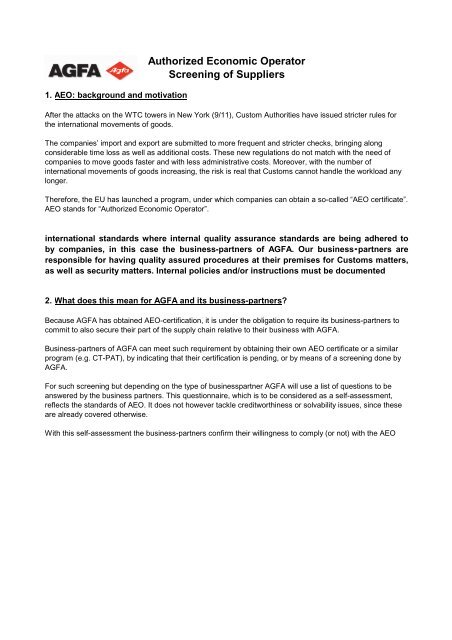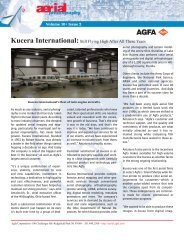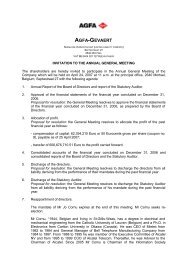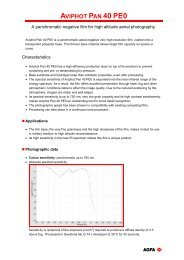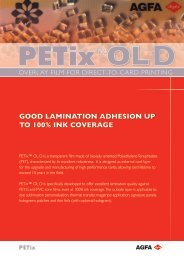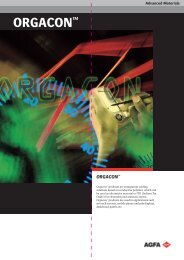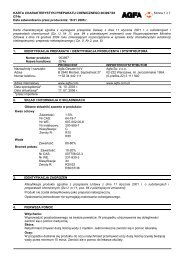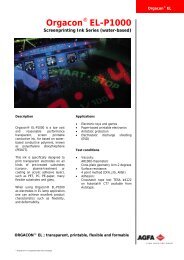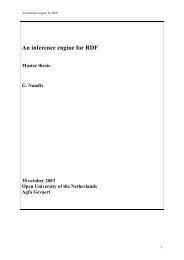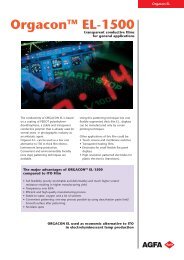AEO Screening questionnaire - Agfa
AEO Screening questionnaire - Agfa
AEO Screening questionnaire - Agfa
You also want an ePaper? Increase the reach of your titles
YUMPU automatically turns print PDFs into web optimized ePapers that Google loves.
1. <strong>AEO</strong>: background and motivation<br />
Authorized Economic Operator<br />
<strong>Screening</strong> of Suppliers<br />
After the attacks on the WTC towers in New York (9/11), Custom Authorities have issued stricter rules for<br />
the international movements of goods.<br />
The companies’ import and export are submitted to more frequent and stricter checks, bringing along<br />
considerable time loss as well as additional costs. These new regulations do not match with the need of<br />
companies to move goods faster and with less administrative costs. Moreover, with the number of<br />
international movements of goods increasing, the risk is real that Customs cannot handle the workload any<br />
longer.<br />
Therefore, the EU has launched a program, under which companies can obtain a so-called “<strong>AEO</strong> certificate”.<br />
<strong>AEO</strong> stands for “Authorized Economic Operator”.<br />
international standards where internal quality assurance standards are being adhered to<br />
by companies, in this case the business-partners of AGFA. Our business‐partners are<br />
responsible for having quality assured procedures at their premises for Customs matters,<br />
as well as security matters. Internal policies and/or instructions must be documented<br />
2. What does this mean for AGFA and its business-partners?<br />
Because AGFA has obtained <strong>AEO</strong>-certification, it is under the obligation to require its business-partners to<br />
commit to also secure their part of the supply chain relative to their business with AGFA.<br />
Business-partners of AGFA can meet such requirement by obtaining their own <strong>AEO</strong> certificate or a similar<br />
program (e.g. CT-PAT), by indicating that their certification is pending, or by means of a screening done by<br />
AGFA.<br />
For such screening but depending on the type of businesspartner AGFA will use a list of questions to be<br />
answered by the business partners. This <strong>questionnaire</strong>, which is to be considered as a self-assessment,<br />
reflects the standards of <strong>AEO</strong>. It does not however tackle creditworthiness or solvability issues, since these<br />
are already covered otherwise.<br />
With this self-assessment the business-partners confirm their willingness to comply (or not) with the <strong>AEO</strong>
TOPICS & QUESTIONS Yes No Comment/ answer/ description Critical<br />
1. Personnel<br />
1.1 Are prospective applicants screened on workhistory,background,references ? Yes No<br />
1.2 Do internal labourregulations (as part of labourcontract) include a code of conduct regarding security ? Yes No<br />
1.3 Does staff receive appropriate and regular training with regard to security and safetyrequirements ( such as security<br />
Yes No<br />
protocols, detection of intrusion/tampering,reporting of incidents and the risks associated with international supply chains)<br />
?<br />
1.4 Are records made and maintained about all training activities ? Yes No<br />
1.5 Are there procedures in place (and followed) to remove identification, facility and systemsaccess,.. Upon termination of<br />
the labourcontract ?<br />
Yes No<br />
2. ITC security<br />
2.1 Please list which software you use to manage your supply chain ?<br />
2.2 Are passwords used to access software ? Yes No<br />
2.3 Is it required to change passwords regularly ? Yes No<br />
2.4 Is usage of ITC ( rules of conduct,..) in place and published ? Yes No<br />
2.5 Does employer monitor the access to systems ? Yes No<br />
2.6 Is there a segregation of duties between users ,developers,analysts ? Yes No<br />
2.7 Do you have a description of the measures regarding protection of hardware and software (firewalls,antivirus,disaster<br />
Yes No<br />
recovery,…) ?<br />
2.8 Did you describe backuproutines ,serverroomprotection,… ? Yes No<br />
3. Physical Security and access control<br />
3.1 Do you prevent unauthorised access to your site(s) ( avoiding intrusion,unlawful entry) ? Yes No<br />
3.2 Do you have a visitor's policy in place including identification and registration of visitors ? Yes No<br />
3.3 Do you regularly assess the physical security of your sites(s)? Yes No<br />
3.4 Do you have an employee identification including accescontrol in place ? Yes No<br />
3.5 Do you control and record visitors/staff/contractors/vehicles attending your premises ? Yes No<br />
4. Secured (un)loading of trucks/trailers/containers (ttc)<br />
4.1 Do you prevent unauthorised access to shipping areas,loading docks,warehouses, etc ? Yes No<br />
4.2 Do you inspect upon (un)loading the t.t.c. ? (for ex. 7 point inspection : bottom,top ,4 outsides and inside) Yes No<br />
4.3 Are full/empty t.t.c's stored in a secure place to avoid unauthorised access Yes No<br />
4.4 Are all goods that need to be stored and/or shipped properly labeled and identified and kept track of ? Yes No<br />
5. Usage of seals<br />
5.1 Are the seals kept in a secure place with limited access only ? Yes No<br />
5.2 Do you have a log capturing t.t.c-number,sealnumber,staffmember who did the sealing ? Yes No<br />
5.3 In case of unloading a sealed t.t.c ,do you verify the integrity ? Yes No<br />
6. Compliance record<br />
6.1 Did you, during the last 3 years , seriously infringe customs rules ? However the record of compliance may be considered<br />
as acceptable if the infringements are of minor or negligible importance in relation to the number /size of customs related<br />
operations/activities . In any case there should not be any fraudulent intent or negligence and remedial actions are to be<br />
taken in order to prevent or minimize future orders .<br />
Yes<br />
No


